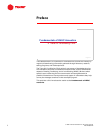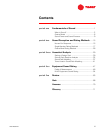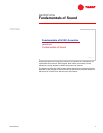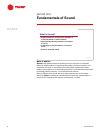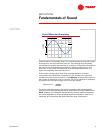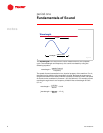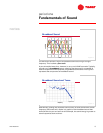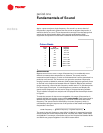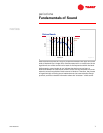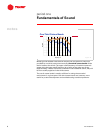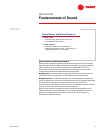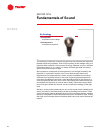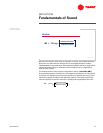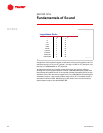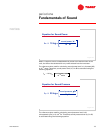
6 TRG-TRC007-EN
notes
period one
Fundamentals of Sound
Again, a pure tone has a single frequency. If a sound in a narrow band of
frequencies is significantly greater than the sound at adjacent frequencies, it
would be similar to a tone. Tones that stand out enough from the background
sound can be objectionable. Many of the sounds generated by HVAC
equipment and systems include both broadband and tonal characteristics.
Octave Bands
Because sound occurs over a range of frequencies, it is considerably more
difficult to measure than temperature or pressure. The sound must be
measured at each frequency in order to understand how it will be perceived in a
particular environment. The human ear can perceive sounds at frequencies
ranging from 20 to 16,000 Hz, whereas, HVAC system designers generally focus
on sounds in the frequencies between 45 and 11,200 Hz. Despite this reduced
range, measuring a sound at each frequency would result in 11,156 data points.
For some types of analyses, it is advantageous to measure and display the
sound at each frequency over the entire range of frequencies being studied.
This is called a full-spectrum analysis and is displayed like the example shown
in Figure 7.
To make the amount of data more manageable, this range of frequencies is
typically divided into smaller ranges called octave bands. Each octave band is
defined such that the highest frequency in the band is two times the lowest
frequency. The octave band is identified by its center frequency, which is
calculated by taking the square root of the product of the lowest and highest
frequencies in the band.
The result is that this frequency range (45 to 11,200 Hz) is separated into eight
octave bands with center frequencies of 63, 125, 250, 500, 1,000, 2,000, 4,000,
and 8,000 Hz. For example, sounds that occur at the frequencies between 90 Hz
and 180 Hz are grouped together in the 125 Hz octave band.
Octave Bands
octave
band
1
2
3
4
5
6
7
8
octave
band
1
2
3
4
5
6
7
8
center
frequency (Hz)
63
125
250
500
1,000
2,000
4,000
8,000
center
frequency (Hz)
63
125
250
500
1,000
2,000
4,000
8,000
frequency
range (Hz)
45 to 90
90 to 180
180 to 355
355 to 710
710 to 1,400
1,400 to 2,800
2,800 to 5,600
5,600 to 11,200
frequency
range (Hz)
45 to 90
90 to 180
180 to 355
355 to 710
710 to 1,400
1,400 to 2,800
2,800 to 5,600
5,600 to 11,200
Figure 8
center frequency lowest frequency × highest frequency =



